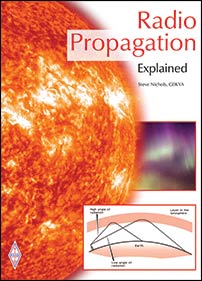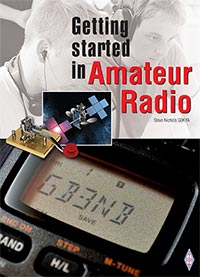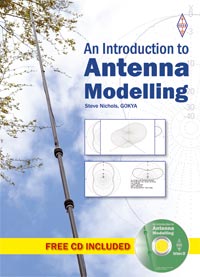I've now updated my hourly HF propagation charts for the UK for the next three months.
The charts, with real time solar information, can be found at http://www.infotechcomms.co.uk/propcharts/
You can definitely see the effects of the current poor solar conditions. As the charts are produced by VOACAP it is suggested we use the smoothed sunspot number (SSN) for the calculations.
In January 2016 the SSN was 44.8, but this month it is just 29.2. In fact, the actual daily sunspot number is even lower than this at around zero to 11 with a solar flux index in the low 70s.
Given that at sunspot minimum we wouldn't expect the solar flux index to drop below 66 you can see that we are very close to the kind of conditions we can expect over the next few years.
NASA says the current sunspot cycle is the smallest since cycle 14, which had a maximum smoothed sunspot number of 107.2 in February of 1906.
The current prediction for sunspot cycle 24 (this one) gives a smoothed sunspot number maximum of about 101 in late 2013.
The next sunspot minimum is currently predicted to occur around 2019-2020.
The solar maximum for cycle 25 is predicted to be around 2025, possibly with a monthly smoothed maximum sunspot number of around 60-65. If true, this is almost down to Dalton Minimum levels.
What we are seeing is that the ionosphere is currently struggling to regularly open up to DX at frequencies much higher than about 18MHz. Around the UK we are even finding 40m (7MHz) closing to inter-G contacts by early afternoon, if it opens at all.
This means that 80m (3.5MHz) and 60m (5MHz) are coming into their own, although both are struggling with inter-G contacts by late afternoon.
A succession of coronal holes and their associated high-speed solar wind streams are also causing disruption to the ionosphere. While these are typical of this point in the sunspot cycle they are generally not helping DX at all.
This week's high K indices have been caused by such a hole, although the solar wind has mostly had a north-facing Bz field, which is less likely to couple with the Earth's magnetic field, and we have't seen the very high K indices that indicate severe auroral conditions.
Lastly, readers might be interested in a new HF propagation tool based on the ITU's ITURHFPROP software and developed by Gwyn G4FKH. The URL is http://www.predtest.uk
The 'Area Coverage' predictions have been available for some time, but a new Point-to-Point prediction tool is now available. Clicking on the link starts the process, when the form is filled out a series of plots are available depicting propagation between the required Tx. and Rx. sites.
New features include various colour schemes for the plots allowing users with colour preferences to make the best viewing choice for themselves.
Steve G0KYA
The charts, with real time solar information, can be found at http://www.infotechcomms.co.uk/propcharts/
You can definitely see the effects of the current poor solar conditions. As the charts are produced by VOACAP it is suggested we use the smoothed sunspot number (SSN) for the calculations.
In January 2016 the SSN was 44.8, but this month it is just 29.2. In fact, the actual daily sunspot number is even lower than this at around zero to 11 with a solar flux index in the low 70s.
Given that at sunspot minimum we wouldn't expect the solar flux index to drop below 66 you can see that we are very close to the kind of conditions we can expect over the next few years.
NASA says the current sunspot cycle is the smallest since cycle 14, which had a maximum smoothed sunspot number of 107.2 in February of 1906.
The current prediction for sunspot cycle 24 (this one) gives a smoothed sunspot number maximum of about 101 in late 2013.
The next sunspot minimum is currently predicted to occur around 2019-2020.
The solar maximum for cycle 25 is predicted to be around 2025, possibly with a monthly smoothed maximum sunspot number of around 60-65. If true, this is almost down to Dalton Minimum levels.
What we are seeing is that the ionosphere is currently struggling to regularly open up to DX at frequencies much higher than about 18MHz. Around the UK we are even finding 40m (7MHz) closing to inter-G contacts by early afternoon, if it opens at all.
This means that 80m (3.5MHz) and 60m (5MHz) are coming into their own, although both are struggling with inter-G contacts by late afternoon.
A succession of coronal holes and their associated high-speed solar wind streams are also causing disruption to the ionosphere. While these are typical of this point in the sunspot cycle they are generally not helping DX at all.
This week's high K indices have been caused by such a hole, although the solar wind has mostly had a north-facing Bz field, which is less likely to couple with the Earth's magnetic field, and we have't seen the very high K indices that indicate severe auroral conditions.
Lastly, readers might be interested in a new HF propagation tool based on the ITU's ITURHFPROP software and developed by Gwyn G4FKH. The URL is http://www.predtest.uk
The 'Area Coverage' predictions have been available for some time, but a new Point-to-Point prediction tool is now available. Clicking on the link starts the process, when the form is filled out a series of plots are available depicting propagation between the required Tx. and Rx. sites.
New features include various colour schemes for the plots allowing users with colour preferences to make the best viewing choice for themselves.
Steve G0KYA














Predictions are always interesting to follow, but can become a bit of an iron rod. If one relies too heavily, it's easy to feel despondent and give up at solar minimum. There are plenty of DX openings, albeit transient ones, still available as high as 12m. It's just a question of keeping at it and not falling into such a herd mentality that nobody actually sends anything, believing bands to be dead. I bagged a KH on PSK-31 last time 15m was 'dead'...
ReplyDeleteThis is very true, although as you say the openings can be transitory and difficult to predict. Predictions are, after all, just giving you probabilities of openings. I'm just listening to a very loud OH beacon on 17m (18.110MHz). There very few other signals on the band!
ReplyDelete